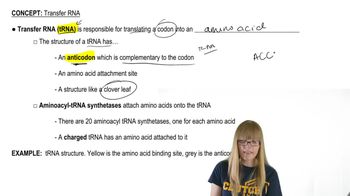In some organisms, cytosine is methylated at carbon 5 of the pyrimidine ring after it is incorporated into DNA. If a 5-methyl cytosine molecule is then hydrolyzed, what base will be generated?
Table of contents
- 1. Introduction to Genetics51m
- 2. Mendel's Laws of Inheritance3h 37m
- 3. Extensions to Mendelian Inheritance2h 41m
- 4. Genetic Mapping and Linkage2h 28m
- 5. Genetics of Bacteria and Viruses1h 21m
- 6. Chromosomal Variation1h 48m
- 7. DNA and Chromosome Structure56m
- 8. DNA Replication1h 10m
- 9. Mitosis and Meiosis1h 34m
- 10. Transcription1h 0m
- 11. Translation58m
- 12. Gene Regulation in Prokaryotes1h 19m
- 13. Gene Regulation in Eukaryotes44m
- 14. Genetic Control of Development44m
- 15. Genomes and Genomics1h 50m
- 16. Transposable Elements47m
- 17. Mutation, Repair, and Recombination1h 6m
- 18. Molecular Genetic Tools19m
- 19. Cancer Genetics29m
- 20. Quantitative Genetics1h 26m
- 21. Population Genetics50m
- 22. Evolutionary Genetics29m
7. DNA and Chromosome Structure
DNA Structure
Problem 31d
Textbook Question
A primitive eukaryote was discovered that displayed a unique nucleic acid as its genetic material. Analysis provided the following information:
About 75 percent of the sugars are deoxyribose, while 25 percent are ribose.
Postulate a model for the structure of this molecule that is consistent with the foregoing observations.
 Verified step by step guidance
Verified step by step guidance1
Analyze the sugar composition: The presence of 75% deoxyribose and 25% ribose suggests that the genetic material is a hybrid molecule containing both DNA and RNA components. This is unusual, as most organisms use either DNA or RNA exclusively as their genetic material.
Consider the structural implications: Deoxyribose is the sugar found in DNA, while ribose is the sugar found in RNA. The coexistence of these sugars implies that the molecule may have regions resembling DNA and regions resembling RNA, or it may have a mixed structure where both sugars are incorporated into the same strand.
Postulate the backbone structure: The backbone of the molecule would likely consist of alternating sugar and phosphate groups, as is typical for nucleic acids. However, the sugars in the backbone would vary between deoxyribose and ribose, depending on the region of the molecule.
Examine the base-pairing possibilities: If the molecule has double-stranded regions, the base-pairing rules (adenine-thymine and guanine-cytosine in DNA, adenine-uracil and guanine-cytosine in RNA) may vary depending on whether the region is DNA-like or RNA-like. This could lead to unique hybrid base-pairing interactions.
Propose a functional role: The hybrid nature of the molecule might provide functional advantages, such as increased stability from the DNA-like regions and increased flexibility or catalytic potential from the RNA-like regions. This could be an adaptation to the primitive eukaryote's environment or life cycle.
 Verified video answer for a similar problem:
Verified video answer for a similar problem:This video solution was recommended by our tutors as helpful for the problem above
Video duration:
1mPlay a video:
Was this helpful?
Key Concepts
Here are the essential concepts you must grasp in order to answer the question correctly.
Nucleic Acids
Nucleic acids, such as DNA and RNA, are biopolymers essential for all known forms of life. DNA (deoxyribonucleic acid) typically contains deoxyribose sugar, while RNA (ribonucleic acid) contains ribose sugar. The presence of both sugars in the genetic material of the primitive eukaryote suggests a hybrid structure, which may indicate a unique evolutionary adaptation.
Recommended video:
Structure of DNA and RNA
The structure of DNA is a double helix formed by two strands of nucleotides, while RNA is usually single-stranded. Each nucleotide consists of a sugar, a phosphate group, and a nitrogenous base. The unique combination of deoxyribose and ribose sugars in the nucleic acid of the primitive eukaryote implies a complex structure that may incorporate features of both DNA and RNA.
Recommended video:
Guided course

DNA Structure
Genetic Material Function
Genetic material serves as the blueprint for the development, functioning, and reproduction of organisms. It encodes the information necessary for protein synthesis and regulates cellular activities. Understanding the function of the unique nucleic acid in the primitive eukaryote is crucial for hypothesizing its role in the organism's biology and evolutionary significance.
Recommended video:
Guided course

Functional Genomics
Related Videos
Related Practice
Textbook Question
565
views



